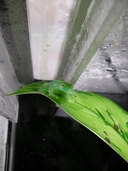|
Cochranella euknemos (Savage & Starrett, 1967)
Fringe-Limbed Tree Frog, Ranita de Cristal | family: Centrolenidae subfamily: Centroleninae genus: Cochranella |
 © 2008 Devin Edmonds (1 of 9) |
|
|
|
Description Adult males are 21 to 25 mm SVL while adult females range from 25 to 32 mm. Distinguishing characteristics of this species include the presence of vomerine teeth; long snout with an obtuse profile; a white parietal peritoneum, but colorless hepatic peritoneum; absence of free prepollex, humeral hooks, and humeral spines; presence of well-developed fleshy fringe on posterior and ventral edges of lower arm, hand, lower hindlimb, and foot; green bones in life; dorsal coloration a deep blue-green covered with many raised, moderate-sized yellowish-white tubercles (Savage and Starrett 1967). General characteristics of this species are (1) head rounded in outline from dorsal view; (2) vomerine teeth in series between choanae; (3) tongue small and round; in males paired vocal slits posterior and laterally positioned to tongue; (4) snout long, obtuse in profile; nostrils positioned laterally, inclined upward; (5) eye orbit round, twice diameter of tympanum; pupil horizontally elliptical; membranes transparent; directed forward, completely visible from frontal view, interorbital space about half of head length; (6) tympanum round, directed laterally; (7) canthus rostralis rounded, loreal region slightly concave; (8) distinct fleshy fringe along posteroventral edge running from elbow to disc of finger IV; (9) undersides of palms and fingers smooth, with lateral fleshy margins; (10) palmar tubercle smooth and round, ulnar tubercle elongate; (11) discs wide and truncate on fingers, small and round on toes; (12) webbing between fingers III and IV, and on all toes; (13) hindlimbs long, also with distinct fleshy fringe posteroventral from heel to disc of toe V; (14) elongate inner, but not outer metatarsal tubercle present; (15) throat and chest smooth; in males, wrinkled at single external vocal sac; (16) venter and thigh undersides strongly granulated; (17) below anus, distinct fringe-like ridge forms 2 raised tubercles and a series of small tubercles (Savage and Starrett 1967). Dorsal surface deep blue-green with many yellow-white to bright yellow spots; iris ivory; ivory white border along lip, arm and leg fringes; white subanal ornamentation; ventral side pale yellow-white; abdominal region transparent revealing visible white parietal peritoneum and white viscera (Savage and Starrett 1967). Tadpoles have long tails, elongate bodies, and are pale in color (Savage and Starrett 1967). Distribution and Habitat Country distribution from AmphibiaWeb's database: Colombia, Costa Rica, Panama
Life History, Abundance, Activity, and Special Behaviors The adult female paratype was found to contain black and white ova, similar to those of C. granulosa . Egg clutches were collected, at the same time as males who were calling were collected. Eggs were suspended in jelly masses from leaf tips. Clutches were kept and reared until the tadpoles reached 24 mm in size (Savage and Starrett 1967). This species is considered rare in Costa Rica and Panama but abundant in Colombia (IUCN 2008). Trends and Threats Possible reasons for amphibian decline Habitat modification from deforestation, or logging related activities Comments Cochranella euknemos belongs to the prosoblepon group. A Spanish-language species account can be found at the website of Instituto Nacional de Biodiversidad (INBio).
References
IUCN, Conservation International, and NatureServe. (2008). Global Amphibian Assessment: Cochranella euknemos. www.globalamphibians.org. Accessed on 27 October 2008. Ruiz-Carranza, P.M. and Lynch, J.D. (1991). ''Ranas Centrolenidae de Colombia III: Nuevas especies de Cochranella del grupo granulosa.'' Lozania, (59), 1-18. Ruiz-Carranza, P.M., Ardila-Robayo, M.C., and Lynch, J.D (1996). ''Lista actualizada de la fauna de Amphibia de Colombia.'' Revista de la Academia Colombiana de Ciencias Exactas, Físicas y Naturales, 20(77), 365-415. Savage, J.M., and Starrett, P.H. (1967). ''A new fringe-limbed tree-frog (Family Centrolenidae) from Lower Central America.'' American Society of Ichthyologists and Herpetologists, 1967(3), 604-609. Originally submitted by: Xi Zhai (first posted 2008-10-01) Edited by: Kellie Whittaker (2009-11-02) Species Account Citation: AmphibiaWeb 2009 Cochranella euknemos: Fringe-Limbed Tree Frog <https://amphibiaweb.org/species/1766> University of California, Berkeley, CA, USA. Accessed Jun 15, 2025.
Feedback or comments about this page.
Citation: AmphibiaWeb. 2025. <https://amphibiaweb.org> University of California, Berkeley, CA, USA. Accessed 15 Jun 2025. AmphibiaWeb's policy on data use. |




 Map of Life
Map of Life